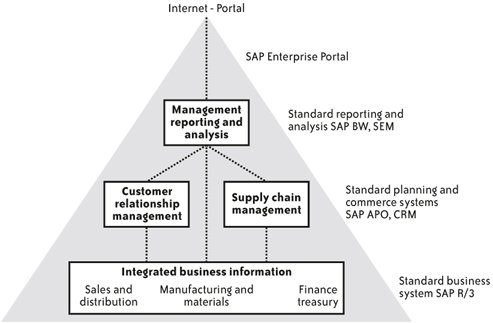Section 17.7. ESA in action: Whirlpool Corporation
17.7. ESA in action: Whirlpool CorporationWhirlpool Corporation practices a more decentralized form of governance. Whirlpool is the world's leading manufacturer and marketer of major home appliances with annual revenues of more than $13 billion, 68,000 employees, and nearly 50 manufacturing and technology research centers around the globe. The company markets its ovens, freezers, dishwashers, washing machines, and thousands of other products under the brand names Whirlpool, KitchenAid, Brastemp, Bauknecht, Consul, and others in more than 170 countries. The company's relentless focus on both customer service and continuous product innovation has already led its IT organization to embrace ESA as a means of enabling business process innovation that will help differentiate products and services and free up resources for reinvestment, instead of simply providing application support. Instead of mapping out a strategic blueprint for ESA adoption from within a central architecture-planning unit (which was actually disbanded several years ago), Whirlpool Corporation has chosen a more tactical, incremental approach. Instead of implementing new enterprise services-based solutions and then consolidating the systems they replaced, Whirlpool Corporation is applying ESA principles when and where it canconverting SAP R/3 EDI messages into XML-based services, for examplewhile resolving to decompose these ad hoc services to more fundamental components when the chance presents itself. Figure 17-2 illustrates Whirlpool's business application vision. Instead of consciously designing an Enterprise Services Repository, for example, Whirlpool Corporation engineers intend to use the imminent replacement of their order management system as an opportunity to decompose the current system to the Remote Function Calls (RFCs) and the transactions that were called by them. Then they plan to recompose these into the first services that someday will fill an Enterprise Services Repository. Whirlpool Corporation's overarching goal is flexible standardization. The company has already standardized around SAP R/3 as the foundation layer of its application hierarchy. This and other transactional systems are connected to the company's primary data center in Michigan and run on the same, consolidated SAP NetWeaver infrastructure. Whirlpool Corporation's governance model is more decentralized, with the core IT group defining 80 percent of a new composite application's functionality in terms of reusable services, then releasing the composite to regional units closer to the business need for implementation of the final interface and need-specific tweaking. That modelwhich manages to accommodate both reusable, standardized components and frontline initiativeswas expressly designed to drive product innovation. Whirlpool intends for its next step to be the standardization of entire manufacturing processes using services once modeling and messaging tools mature. Figure 17-2. Whirlpool's business application vision Until then, the company will continue using enterprise services to consolidate its menagerie of legacy systems. With SAP NetWeaver acting as the platform, legacy applications and data are migrated via the SAP NetWeaver Exchange Infrastructure (XI) and SAP NetWeaver Master Data Management (SAP NetWeaver MDM) to the core SAP R/3 systems, a process that has proven useful in sunsetting custom systems and those from other third-party vendors. |
EAN: 2147483647
Pages: 265